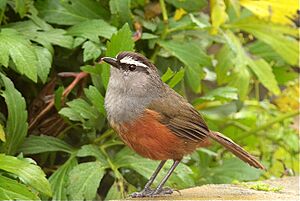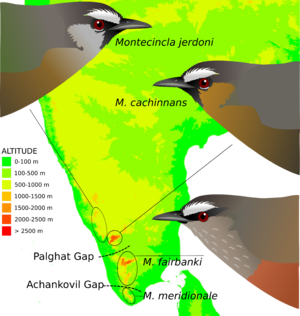Palani laughingthrush facts for kids
Quick facts for kids Palani laughingthrush |
|
|---|---|
 |
|
| in the Meghamalai | |
| Conservation status | |
| Scientific classification | |
| Genus: |
Montecincla
|
| Species: |
fairbanki
|
 |
|
| Synonyms | |
|
Garrulax jerdoni fairbanki |
|
The Palani laughingthrush (Montecincla fairbanki) is a special type of bird. It lives only in the hills of the Western Ghats in Southern India. You can find these birds in high mountain forests. They have a grey chest, a reddish-brown belly, and a clear dark stripe across their eyes. They also have a wide white stripe above their eyes.
This bird was once thought to be part of another group called the grey-breasted laughingthrush. But now, scientists know it's a unique species. The Palani laughingthrush lives in the Palni Hills. A very similar bird, the Ashambu laughingthrush (Montecincla meridionalis), lives further south. These two birds were once called the Kerala laughingthrush.
Contents
What Does the Palani Laughingthrush Look Like?
This bird has a dark grey-brown head. It has a thin dark grey stripe across its eye. Above this stripe, there's a wide white line, like an eyebrow. This white line goes past the eye. The Ashambu laughingthrush has a shorter white line that stops above the eye.
The Palani laughingthrush has a grey throat and upper chest. This grey part has faint brown streaks. Its lower chest and belly are a rusty brown color. The upper parts of its body are olive-brown. Its beak is brownish, not as dark as some other laughingthrushes.
The Ashambu laughingthrush looks a bit different. It has greyer feathers on its upper body and a lighter head. Its belly is white in the middle, with chestnut brown on the sides. Both male and female Palani laughingthrushes look the same. Their eyes are dark red or reddish-brown.
How Scientists Classify the Palani Laughingthrush
Scientists give names to living things to organize them. This bird was first described in the Kodaikanal area. A person named Rev. Samuel B. Fairbank found a specimen, and that's why the bird was named after him. It was called the Pulney laughing-thrush.
At first, scientists noticed it didn't have the black chin of another similar bird. But later, in 1922, it was grouped as a subspecies of that bird. In 1880, another similar bird, meridionale, was described. Scientists soon realized meridionale and fairbanki were closely related.
In 2005, new studies helped scientists understand these birds better. They looked at the Palghat Gap, a natural barrier that separates different animal groups. They also looked at the chin color. Because of this, the birds were regrouped. A study in 2017 suggested that the Palani laughingthrush should be in a new group called Montecincla. This study also showed that meridionale is different enough to be its own species.
Life and Habits of the Palani Laughingthrush
| Measurements | |||
|---|---|---|---|
| Nominate | |||
| Length | 175–185 mm (6.9–7.3 in) | ||
| Culmen | 21–23 mm (0.83–0.91 in) | ||
| Wing | 83–91 mm (3.3–3.6 in) | ||
| 81–86 mm (3.2–3.4 in) | |||
| Tail | 86–97 mm (3.4–3.8 in) | ||
| 86–92 mm (3.4–3.6 in) | |||
| Tarsus | 33–35 mm (1.3–1.4 in) | ||
| meridionale | |||
| Length | 173–190 mm (6.8–7.5 in) | ||
| Culmen | 21–22 mm (0.83–0.87 in) | ||
| Wing | 85–88 mm (3.3–3.5 in) | ||
| 84–85 mm (3.3–3.3 in) | |||
| Tail | 95–96 mm (3.7–3.8 in) | ||
| Tarsus | 35–36 mm (1.4–1.4 in) | ||
Palani laughingthrushes are often seen in pairs or small groups. Sometimes, they even join other bird species to find food together. They like to eat nectar from flowers like Lobelia excelsa, Rhododendron, and Strobilanthes. They also eat flower petals and fruits from plants like Viburnum, Eurya, Rubus, and Rhodomyrtus tomentosa.
Reproduction and Family Life
The breeding season for these birds is from December to June. It's busiest in April and May. They build a cup-shaped nest using grass and moss. They line it with soft fibers. The nest is usually hidden in a low fork of a branch within thick plants.
A female bird usually lays two blue eggs with reddish marks. These eggs look just like those of the black-chinned laughingthrush. If a nest is attacked by predators, or after the young birds leave the nest, the parents will destroy the nest. They might even tear up nests of other birds nearby. Sometimes, if an egg doesn't hatch, the parent birds might eat it.
Bird Calls
These birds have very loud calls. They make a series of rising notes that sound like "pee-koko... pee-koko." They also make other sounds, like a low "kweer" call, depending on what they are doing. Some of their calls sound like two birds singing back and forth to each other.
Where the Palani Laughingthrush Lives
This bird lives only south of the Palghat Gap. Its main home is in the higher parts (above 1,100 meters or about 3,600 feet) of the Palani Hills. Their range also extends into the Annamalai Hills in western Tamil Nadu and Munnar in Kerala.
The main group of Palani laughingthrushes lives north of the Achankovil gap. The meridionale group lives in the hills south of this gap. In the Palni Hills, the number of these birds changes depending on the area. For example, there are more birds in Kukkal than in places like Kodaikanal Botanical Gardens or the golf course.
Gallery




